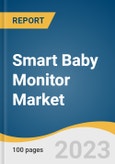The global smart baby monitor market size is expected to reach USD 2,476.0 million by 2030, expanding at 7.9% CAGR from 2023 to 2030. Increasing number of nuclear families and working parents have been fueling the adoption of the product among consumers. In addition, the rising birth rate in countries including Sweden, the UK, Russia, the Czech Republic, and Spain is expected to expand the market size in the upcoming years. Smart baby monitors offer parents the ability to monitor their children's activities, catering to the growing concern for child safety. The increasing presence of working parents, particularly mothers, in countries like the U. S., China, and Canada, is a significant driving force behind the market's growth.
These products alleviate parental stress by enabling real-time communication between parents and their children, even when they are at work or away from home. In addition, the widespread adoption of smartphones has played a crucial role in the industry's expansion, as it allows parents to remotely monitor their child's well-being from any location. The increasing disposable income in emerging economies like Brazil, India, Thailand, and China is anticipated to empower consumers to allocate more funds toward ensuring the safety of their children. The growth of the smart baby monitor industry has been further propelled by the widespread availability of e-commerce platforms, facilitating convenient global access to these products.
Moreover, the recent relaxation of the one-child policy in China is poised to contribute to the expansion of the market in the coming years. Parents of newborns prefer smart baby monitors as these use facial recognition systems, thereby allowing parents to capture memorable moments. Innovations in this product act as a major factor boosting the preference for baby monitors among consumers. For instance, in May 2022, VTech Communications, Inc. introduced its LeapFrog line of baby monitors in Canada. The product line included seven models of video baby monitors and smart video baby monitors. The key features are adaptive color light color night vision, smart remote monitoring, and high-definition video.
These products alleviate parental stress by enabling real-time communication between parents and their children, even when they are at work or away from home. In addition, the widespread adoption of smartphones has played a crucial role in the industry's expansion, as it allows parents to remotely monitor their child's well-being from any location. The increasing disposable income in emerging economies like Brazil, India, Thailand, and China is anticipated to empower consumers to allocate more funds toward ensuring the safety of their children. The growth of the smart baby monitor industry has been further propelled by the widespread availability of e-commerce platforms, facilitating convenient global access to these products.
Moreover, the recent relaxation of the one-child policy in China is poised to contribute to the expansion of the market in the coming years. Parents of newborns prefer smart baby monitors as these use facial recognition systems, thereby allowing parents to capture memorable moments. Innovations in this product act as a major factor boosting the preference for baby monitors among consumers. For instance, in May 2022, VTech Communications, Inc. introduced its LeapFrog line of baby monitors in Canada. The product line included seven models of video baby monitors and smart video baby monitors. The key features are adaptive color light color night vision, smart remote monitoring, and high-definition video.
Smart Baby Monitor Market Report Highlights
- The tracking devices technology segment is projected to register a CAGR of 7.1% from 2023 to 2030. These smart baby monitors connect directly to the child’s body for better monitoring. They track room temperature, movement, heart rate, oxygen levels, sleep pattern, and temperature of the child, thereby providing information about his/her health to the parents
- The offline distribution channel segment held a market share of 73.1% in 2022. Consumers prefer to physically examine and test baby monitors before making a purchase, especially for products related to their child's safety and well-being. Offline channels, such as brick-and-mortar stores, allow customers to have a hands-on experience with the product, assess its features, and seek guidance from sales personnel
- Asia Pacific is expected to register the fastest growth during the forecast period owing to rapid urbanization which has led to increased demand for baby monitoring solutions. Parents living in urban areas often seek ways to ensure the safety and well-being of their children, even when they are not physically present
Table of Contents
Chapter 1. Methodology and Scope
Chapter 2. Executive Summary
Chapter 3. Smart Baby Monitor Market Variables, Trends & Scope
Chapter 4. Consumer Behavior Analysis
Chapter 5. Smart baby monitor Market: Product Estimates & Trend Analysis
Chapter 6. Smart baby monitor Market: Distribution Channel Estimates & Trend Analysis
Chapter 7. Smart baby monitor Market: Regional Estimates & Trend Analysis
Chapter 8. Competitive Analysis
List of Tables
List of Figures
Companies Mentioned
- VTech Communications, Inc.
- Motorola, Inc.
- Dorel Industries Inc.
- Panasonic Corporation
- Samsung Electronics Co. Ltd.
- Netgear Inc.
- Lorex Technology Inc.
- Summer Infant, Inc.
- Arlo Technologies, Inc.
- iBaby Labs, Inc.
Methodology

LOADING...
Table Information
| Report Attribute | Details |
|---|---|
| No. of Pages | 100 |
| Published | August 2023 |
| Forecast Period | 2022 - 2030 |
| Estimated Market Value ( USD | $ 1347.1 Million |
| Forecasted Market Value ( USD | $ 2476 Million |
| Compound Annual Growth Rate | 7.9% |
| Regions Covered | Global |
| No. of Companies Mentioned | 10 |









